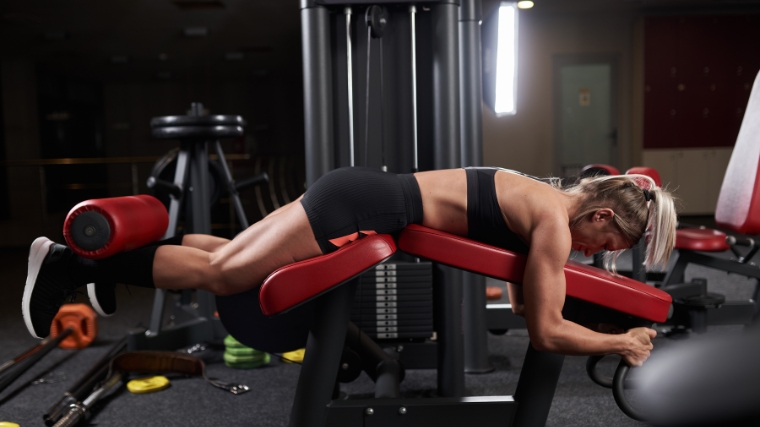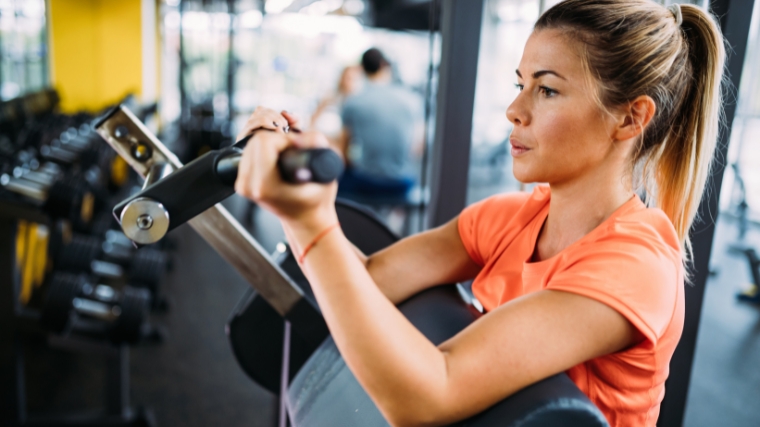The absolute best way to grow muscle, get strong, or become more powerful is routinely up for debate within fitness circles worldwide. Everyone seems to have their preferred method. Between personal experience, gems passed down by prominent coaches, or studious efforts sifting through the literature, it can be hard to know the “right” way to hit the weights.
Layne Norton’s PHAT (that’s power-hypertrophy adaptive training) blends these perspectives into a mix of personal experience, lessons from the past, and recommendations from the more scientific side of things.

If you’re looking to get bigger, stronger, and more powerful, this program is up your alley. This is Layne Norton’s PHAT, explained.
- Program Overview
- Why It Works
- What You’ll Need for PHAT
- How to Modify PHAT
- Who Should Do PHAT
- Who Shouldn’t Do PHAT
- Who Is Layne Norton?
Program Overview
At its core, PHAT was designed as a coercive measure to guarantee muscle growth. Having a foundation of strength and power makes it challenging not to add mass. A bigger and more explosive set of legs will likely happen as an extension of having a super strong squat or deadlift.
PHAT takes the guesswork out of the equation. You’ll no longer be agonizing over finding the “best” method. Instead, you can narrow your focus onto what really matters — effort.
PHAT’s Main Lifts
PHAT is designed to get you bigger, stronger, and more powerful all at once. Therefore, it follows that the main lifts of the program are big compound exercises. Barbell squats, hinge variations, bench pressing, and barbell rowing will serve as the cornerstone of your program.
PHAT Programming
PHAT uses a 5-day split to train your main lifts and their associated muscles across a plethora of accessories and supportive movements.

Your major movement patterns are all exposed to either power or speed training before the 5-day split is complete. The remainder of each workout will carve out every inch of your body with strength and hypertrophy-focused exercises.
These exercises will span repetition ranges from six to 20, helping force muscular growth once the main work has been completed. The assistance and auxiliary exercises have also been selected to provide a balance of pure aesthetic training with performance boosts to the main lifts of the program.
The Intent of PHAT’s Lifting Styles
The name says it all: power, hypertrophy, and adaptation to stimulus. The intent behind each element you’ll be exposed to through PHAT is to help build power and hypertrophy through regular variation.
When you train power, you aim to move as much weight as possible with clean technique. You’ll execute 3-5 sets of 3-5 repetitions here with ample rest to allow for a full recovery. Throw everything you can into these sets, resting up to five minutes between each.
Your speed exercises will mimic your power exercises but with a reduced load on the bar. Again, the intent will be to move as quickly and explosively as possible without losing position. Take no longer than 90 seconds of rest here.

For the hypertrophy exercises, assume a bodybuilder’s mentality. Your goals are training with anywhere from 6-20 repetitions with 1-2 minutes of rest and going for a vicious burn. Make sure you’re getting each set close to failure (leaving about 1-2 repetitions in the tank) while you’re at it to build some good muscle on the tail end of each workout.
PHAT’s Training Load
PHAT employs percentage-based training prescriptions for the majority of the exercises (where applicable). During speed and power training, you will be provided with a recommended percentage of your 1-repetition maximum (1RM) to utilize each time.
Your power days will utilize 3-5 sets of 3-5 repetitions with approximately 70-80 percent of your 1RM on the main lift. You’ll have a bit of leeway to choose exactly which percentage you land on here but err on the side of starting lighter and building over several weeks.
Your speed days will use a percentage of the load you selected for the same lift on the power day. For example, your speed squat would be performed for 6-8 sets of 3 repetitions with 65-70 percent of your power day load.
While having direct guidance on every load for every exercise would be convenient, it becomes less and less feasible to prescribe as the days roll on. Once you’re into the hypertrophy side of things, the goal will be to play around to find the right load that will take you within 1-2 repetitions of muscular failure at the prescribed repetition range.
Using a rating of perceived exertion (or RPE) system here can be helpful, but you should also write down the weights you work with for future reference.
Sample PHAT Training
A mesocycle is a specific period during which you focus on developing one or two attributes. For example, a mesocycle in a program like PHAT might run between 4-6 weeks out of an entire year (or more) of training. This allows you to organize your exercise selection, keep progressing your weights, and most importantly, deload as necessary.
With PHAT, your workouts generally remain the same for an entire mesocycle. However, the absolute load on each of your power or speed exercises is changing.
Norton recommends weaving in a deload once every 6 to 12 weeks, depending on how beat up you feel. During the deload, work with 60 to 70 percent of your normal weights to help maintain your strength.
Day 1: Upper Body Power
- Bent-Over or Pendlay Row: 3 x 3-5
- Weighted Pull-Up: 2 x 6-10
- Rack Chin-Up: 2 x 6-10
- Flat Dumbbell Press: 3 x 3-5
- Weight Dip: 2 x 6-10
- Seated Dumbbell Shoulder Press: 3 x 6-10
- Cambered Bar Biceps Curl: 3 x 6-10
- Skull Crusher: 3 x 6-10
Day 2: Lower Body Power
- Squat: 3 x 3-5
- Hack Squat: 2 x 6-10
- Leg Extension: 2 x 6-10
- Stiff-Legged Deadlift: 3 x 5-8
- Lying Leg Curl: 2 x 6-10
- Standing Calf Raise: 3 x 6-10
- Seated Calf Raise: 2 x 6-10
[RELATED: Best Leg Exercises]
Day 3: Rest
Day 4: Back and Shoulder Hypertrophy
- Bent-Over or Pendlay Row: 6 x 3
- Chin-Up: 3 x 8-12
- Seated Cable Row: 3 x 8-12
- Dumbbell Row: 2 x 12-15
- Close-Grip Pulldown: 2 x 15-20
- Seated Dumbbell Press: 3 x 8-12
- Upright Row: 2 x 12-15
- Dumbbell Lateral Raise: 3 x 12-20
Day 5: Lower Body Hypertrophy
- Squat: 6 x 3
- Hack Squat: 3 x 8-12
- Leg Press: 2 x 12-15
- Leg Extension: 3 x 15-20
- Romanian Deadlift: 3 x 8-12
- Lying Leg Curl: 2 x 12-15
- Seated Leg Curl: 2 x 15-20
- Donkey Calf Raise: 4 x 10-15
- Seated Calf Raise: 3 x 15-20
Day 6: Chest and Arms Hypertrophy
- Flat Dumbbell Press: 6 x 3
- Incline Dumbbell Press: 3 x 8-12
- Hammer Strength Chest Press: 3 x 12-15
- Incline Cable Flye: 2 x 15-20
- Cambered Bar Preacher Curl: 3 x 8-12
- Dumbbell Concentration Curl: 2 x 12-15
- Spider Curl: 2 x 15-20
- Cambered Bar Seated Triceps Extension: 3 x 8-12
- Cable Pressdown: 2 x 12-15
- Cable Kickback: 2 x 15-20
Day 7: Rest
Note: After each successful training week, try adding 2.5 percent of your 1RM to your training loads on power and speed exercises.
Why It Works
Layne Norton’s PHAT method works because it ties together several well-documented training philosophies. It employs periodization to fuel your main lifts, goes hard on concurrent training, and allows you to get a ton of technical practice in as well.
Periodization
Periodization is a form of programming structure that allows you to manage your progress better. When you periodize your program, you incorporate predetermined increases in load, sets, repetitions, or some combination, with well-timed rest periods.
Periodization helps to assure your progress by adding objectivity to your decision-making and balancing progressive overload with recoverability.
Concurrent Training
Concurrent training is a method of organizing your workouts to attack a few different goals or adaptations at the same time. As the name indicates, PHAT is about improving your power and hypertrophy.
Both adaptations can synergistically help with long-term powerlifting and bodybuilding performance, so training them concurrently in the same program makes sense. They are also similar enough to be trained simultaneously without being detrimental to your progress on either front.
Lots of Practice
You will be exposed to a ton of quality technique practice on each compound exercise you perform during PHAT. In many ways, seeing gains in strength, power, and hypertrophy comes down to how well you can execute your exercises.
With PHAT, you will be exposed to each main lift twice weekly. Throughout a few mesocycles, you should see major improvements in your technique. This technical improvement should translate to heavier loads, less wasted energy, and a better return on investment for your power and hypertrophy training.
What You’ll Need for PHAT
Layne Norton’s PHAT is a powerbuilding program. It’s designed to get you strong, powerful, and jacked. With that in mind, there are some equipment requirements that you should consider before starting up.
Barbells and Dumbbells
To run PHAT, you’ll need access to barbells and dumbbells. All main lifts will require you to use a barbell or dumbbell variation of the basic compound movement patterns.
You’ll also need access to plenty of weight plates. The stronger you get, the more plates and heavier dumbbells you’ll need. Be sure to plan ahead and have a good facility or home gym set up to accommodate your training.
Machines
Layne Norton’s PHAT calls for using many machines for accessory and auxiliary exercises as a hybrid program for both power and hypertrophy. You’ll find yourself smashing some hard sets on various machines each workout. A fully-stocked commercial gym facility is ideal here.
How to Modify PHAT
PHAT has a concrete structure, but you can modify if necessary. While the exact expected results are based on following the program to the letter, you can still see significant progress while tailoring it to suit your needs.
Swapping Exercises
You may not have access to the exact complement of machines or exercises called for during PHAT. It is a fairly comprehensive program that prescribes a large variety of machine or cable work. For example, a cambered bar or specific machine may not be readily available. In these cases, go for a free-weight analog instead.
Making Up Time
PHAT is a 5-day split. Although hitting all five days as written would be ideal to stay in line with the letter of the program, sometimes life happens.
Whether you need more recovery time, work or family life interrupts your normal schedule, or any unforeseen circumstances occur, you can simply extend your “training week.” Continue the program as written, but take as much time as necessary to complete all the workouts.

You can prescribe yourself a two or three-day break from the gym to get back on schedule with little to no ill effect.
Deload Timing
Norton recommends taking a deload once every 6 to 12 weeks during PHAT. This gives you a ton of wiggle room for where to utilize your break. Your best bet is to wait until training feels particularly hard or you can’t seem to generate much power during your power-focused movements. Either way, think hard about when to deload and avoid taking too many breaks if possible.
Who Should Do PHAT
Layne Norton’s PHAT method is not for the faint of heart. Intermediate athletes, powerlifters, and bodybuilders likely make the best candidates for this training style.
Intermediate Gymgoers
You should have some training experience under your belt before taking on PHAT. It calls for a reasonably heavy-duty workload over five days. Knowing your limits and how to recover best are big assets here, so waiting until you’re in a more intermediate phase of your training is wise.
Powerlifters
Powerlifters can do well with PHAT, particularly during the off-season, as the main lifts are often the same as their competition exercises. There will be a ton of squat, press, and hinge training, all of which are relevant for the powerlifter.
The combined power, speed work, and hypertrophy are heavily synergistic with powerlifting performance, so if you’re already powerlifting, it’s worth a shot.
Bodybuilders
Bodybuilders are also in a position to make serious gains with PHAT. One of the original intentions behind the program was to help build some crazy legs (for both aesthetics and strength). This falls right in the wheelhouse for a bodybuilder to hybridize their training method and soak up some new progress.
Who Shouldn’t Do PHAT
Again, Layne Norton’s PHAT method is not for the faint of heart. Beginners, those with low equipment access, and those without a ton of time are likely not strong candidates for the program.
Beginners
Beginners are likely not in the position to get the most gains possible from PHAT. It is a highly demanding program requiring competence in challenging lifts like the squat, press, and deadlift.

It also can be tough to recover from if your body hasn’t had some exposure to bodybuilding or high-intensity powerlifting before. If you’re still a beginner, give yourself some more time to grow before taking on PHAT.
If You Train at Home
You’ll need much more than a basic barbell to run PHAT properly. Much of the accessory training relies on access to exercise machines and cable stations which you probably don’t have at home. Don’t try to force PHAT to fit where it isn’t appropriate; you’ll need a gym for this one.
Those Strapped for Time
Given the exercise selection, set and repetition schemes, and rest periods, PHAT workouts can take a lot of time. Each main lift calls for some serious rest between the working sets, and you’ll need to thoroughly warm up to get there.
Afterward, there’s still a relatively long bout of bodybuilding to follow. If you cannot allocate between eight and 12 hours per week to the weight room, PHAT might not be right for you.
Who Is Layne Norton?
Layne Norton is a fixture within the fitness industry. His pedigree stretches across both powerlifting and bodybuilding, and he is also an accomplished researcher and content creator.
According to Open Powerlifting, Norton has competed in powerlifting since 2009 and boasts an impressive second-place finish at the International Powerlifting Federation’s (IPF) World Classic Championships in 2015.
His competition best lifts include a 668-pound raw squat, a 727.5-pound deadlift, and a 391.3-pound bench press. On top of his performance under the barbell, Norton also has his Ph.D. in nutritional science. In many ways, PHAT is the culmination of a career full of practical and theoretical knowledge.
“PHAT” Gains
Power-hypertrophy adaptive training is a harmonious combination of powerlifting and bodybuilding. PHAT takes an aggressive stance on growing muscle, getting stronger, and breaking through stubborn plateaus.
While not necessarily for the inexperienced lifter, this trial-by-iron is certainly attractive to heavy-lifting fanatics. Be prepared for exercises of all varieties, set some time aside for hard training sessions and recovery, and bask in the “PHAT” gains Layne Norton’s program all but guarantees.
Featured Image: Lebedev Roman Olegovich / Shutterstock